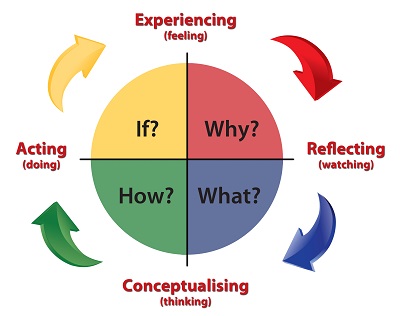Here’s a quick quiz.
See which one of these four behavioural descriptions you MOST vibe with.
- You want to know “why?” Why should I do this? Why is this relevant to me? What’s in it for me? Why should I listen to you and why now? You rebel against any form of “just do it because I told you to”.
- You’re an information sponge. Theory, facts and figures excite you. The more the better. You learn for the sake of learning. At the extreme, no amount of detail is enough. You’re not that concerned about the “why” or what you could do with it in practical terms.
- Maybe you’re an experimenter. You immediately want to “play with it”, take it apart to see how it ticks, learn how all the bits and pieces fit together. In chemistry class you wanted to put two chemicals together to see if it went boom.
- And finally, you’re a classic “what if” person. A lateral thinker. You’re constantly thinking about possibilities. Figuring out different ways to do/use whatever you’ve come across. Theory and experimenting bore you. As to detailed information, who cares!
Now I hasten to add, we all have every one of these characteristics. However, some may be more pronounced than others.
So what’s this got to do with persuasion? Well, everything!
Great persuaders know they have to cater to each “type” by answering the following questions.
“Why”, “What”, “How” and “What if” – and most importantly – in that sequence!
Here’s why…
Let’s start with “Why” people.
Comprising around 35% of the population, a person who “lives” in the “why” simply won’t listen to anything you have to say until you’ve satisfied their “why”.
Why they should be giving you the time of day. Why should they read, listen, watch what you’re offering? What’s in it for them? How is it going to enhance their lives, businesses etc.? What problem is it going to solve?
You could have the best product or service on the market, something that you know they should be interested in, but unless you take the time to answer their “why”, your pitch will fall on deaf ears, resulting in lost sales.
Some marketing formulas call this the Getting Attention Phase. If you can’t get their attention in the headline, first paragraphs of your copy or the first couple of minutes of your presentation, you’ll lose them and they’ll simply not care about what you have to say.
We then move into the “What” area – which around 22% of the population falls into.
Ever been in a technical presentation which comprises of nothing but facts? You sit there eyes glazing over wondering what it’s all about? Chances are the presenter falls into the “What” space and loves dishing out copious quantities of information – whether you think it’s relevant or not.
Yes, information regarding your product or service is vital. However, it’s only one part of the sales process.
18% of your audience will want to know “how” your product or service works. How will it be delivered. What’s involved. They want a process from A – Z so they can get a handle on it. Use real examples to get your point across.
And finally 25% are already seeing the possibilities of “What if”. They’ve bought into your idea and your role is to help them see other possibilities of how they can use your material.
While we all utilise each style, we have a preference for an individual style which must be satisfied before we’ll give you our full attention. And if you’re to make a sale, you must cover all four bases.
Are you using this structure in your own marketing material? Do you answer your prospect’s “Why”, “What”, “How” and “What if”?
And yes, this is exactly the structure you should use with any presentation, seminar, webinar you deliver. Or risk losing significant parts of your audience.
And finally, some of you might have noticed this structure directly relates the 4Mat learning system created by Bernice McCarthy in 1980. Based on years of research into how people learn and process information, 4Mat has become one of the best known methods of designing courses and instructional material.
All of which makes sense as marketing and selling is all about first generating interest, then educating your audience and finally showing them the possibilities of your solution.
Want help developing your own marketing or presentation material? Hit reply and we’ll talk.
